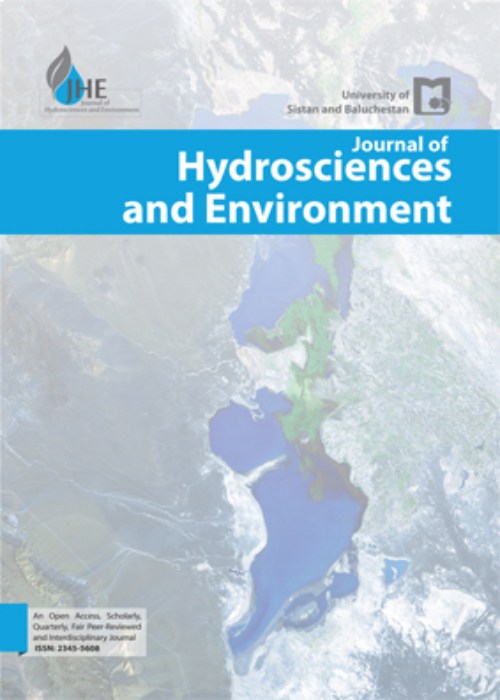فهرست مطالب

Journal of Hydrosciences and Environment
Volume:7 Issue: 13, Jun 2023
- تاریخ انتشار: 1402/08/21
- تعداد عناوین: 4
-
Pages 1-9Drought is a climatic phenomenon that almost happens in every climate situation, because Iran country is located in the arid belt of earth, the importance of drought and analyzing it in the past and future is important for us to programming and managing the water resources. In this research which was done in the study area of the watershed region of Kashfrud, the effect of climatic changes in the climatic precipitation parameter under two scenarios of RCP4.5 and RCP8.5 in the study period (19987-2016) was analyzed and surveyed. To analyze drought in the study region by using Standard Precipitation Index (SPI) and surface water supply index (SWSI), the occurrence and time of climatic and hydrological drought were analyzed. For predicting the future period precipitation by atmospheric general circulation model of MIROC5 and by using small scale (Delta) method under release scenarios RCP4.5 and RCP8.5, the future precipitation data were achieved, then standard precipitation index in the next 30 years’ period (2019-2048) was calculated. Using the implemented calculations in standard precipitation index and analyzing the results in the next 30 years, the number of dry and very dry months; means index number less than - 1.5, in the study area was achieved. Based on the achieved results from the standard precipitation index (SPI) in the annual scale in Mashhad and Golmakan station, the first decades of the study period (1987-1996) and future periods (2019-2028) are the driest periods. Also, the results of hydrologic drought index in annual scale in Mashhad station indicates 19 dry years and in Golmakan station indicates 16 dry years.Keywords: drought, Climatic changes, RCP scenarios, Atmospheric general circulation model, Kashfrud
-
Pages 10-15
The integration of urban services is one of the most important achievements of the urban geographic information system (GIS), which will clarify, unify and facilitate services by creating a database in GIS, and it will be a step in the direction of reaching the urban information management system and decision support of senior city managers, which can be used as a new and powerful tool for better city management. Gathering information (spatial and descriptive) of all aspects of green space in the region, elements, furniture and urban facilities in Qochan city is one of the main operations to achieve better management in the region. Using Quick Bird satellite images and evaluating the potential of these data in producing a number of green space information layers such as linear, point and surface complications and the ability to update area information is one of the activities that makes it easy for managers to access information.
Keywords: Urban green space planning, GIS, Remote Sensing -
Pages 16-24Although the total amount of precipitation in climate surveys is seen as an important factor in determining climatic conditions, and finally, ecological circumstances, but, its seasonal distribution, and to be more precise, its compliance with environmental requirements, particularly agriculture, is of great importance as well. In this study, we tried to regionalize the annual precipitation totals and the precipitation regime of Helmand basin on a regional scale, which is located in South West Asia, shared between three countries of Afghanistan, Iran and Pakistan. To this end, TRMM satellite rainfall productions with spatial resolution of 0.25 * 0.25 degrees for a 15-year period (2000-2014) have been used. To regionalize these two precipitation features in the Helmand basin, the cluster analysis by Ward linkage method was used. Performing the cluster analysis on Helmand basin annual precipitations, it was found that three rainfall areas can be identified in this basin: Eastern high precipitation region with an average annual rainfall of 256.7 mm, Central moderate precipitation region with an average annual rainfall of 171.5 mm and Western low precipitation region with an average annual rainfall of 86.1 mm. In addition, performing cluster analysis on the relative precipitation per month indicated that two different precipitation regimes, namely, winter precipitation regime and winter- spring precipitation regime can be distinguished in this basin. The winter precipitation regime prevails in the west of the basin, while the winter-spring precipitation regime prevails in the center and east of the basin. The winter precipitation regime is a regime that close to 63.4% of its total annual precipitation falls in the winter. The winter-spring precipitation regime of this basin is a regime that most of its precipitation occurs first in winter (44%) and then in the spring (30.5%).Keywords: Precipitation, Regionalizing, Cluster analysis, TRMM, Precipitation Regime, Helmand Basin
-
Pages 25-29Different natural hazards which are sometimes caused by climatic processes such as fires, have put human life at stake throughout the course of history. Forest fire which is said to be one of the major causes of deforestation has been recognized as a major crisis in recent years. Satellite imagery and remote sensing techniques can effectively contribute to investigation of forest and rangeland fires. In the present study, the GEE system was used to assess the severity of fire in the Arasbaran Protected Area. For this purpose, Landsat 8 and Sentinel 2 satellite images as well as NBR (normal burning ratio) and dNBR indices were used for this purpose. According to the results, the map of areas with high fire risk can effectively contribute to forest fire management across the region.Keywords: Forest fire, Arasbaran region, dNBR index, Remote Sensing

